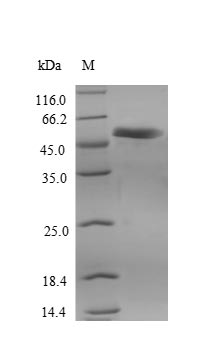Recombinant Human Receptor-interacting serine/threonine-protein kinase 3 (RIPK3) is expressed in yeast and includes the complete protein sequence (1-518 amino acids) with an N-terminal 6xHis-tag that makes purification more straightforward. SDS-PAGE analysis shows the protein is over 90% pure, which should provide reliable results for research work. This product is meant for research use only and isn't intended for therapeutic or diagnostic applications.
RIPK3 appears to play a central role in controlling programmed cell death pathways, especially necroptosis. The protein works with other cellular components to help form necrosomes, which trigger cell death through pathways that differ from traditional apoptosis. Because of its involvement in necroptosis, RIPK3 has become an important focus for researchers studying cell death, inflammation, and immune responses. These studies may offer valuable insights into both normal physiological processes and disease mechanisms.
Potential Applications
Note: The applications listed below are based on what we know about this protein's biological functions, published research, and experience from experts in the field. However, we haven't fully tested all of these applications ourselves yet. We'd recommend running some preliminary tests first to make sure they work for your specific research goals.
Based on the provided information, the folding state and bioactivity of this recombinant RIPK3 protein are unknown and cannot be assumed. RIPK3 is a serine/threonine kinase that requires correct folding of its kinase domain and proper oligomerization for its role in necroptosis signaling. While the protein is expressed as full-length (1-518aa) in a yeast system (which can provide eukaryotic folding machinery), the presence of an N-terminal 6xHis tag could potentially interfere with the protein's N-terminal structure or function. The >90% purity indicates minimal contaminants but does not confirm correct tertiary structure, kinase activity, or ability to participate in signaling complexes. Therefore, applications that depend on specific biological activity or native conformation are speculative without experimental validation.
1. Protein-Protein Interaction Studies Using His-Tag Pull-Down Assays
The N-terminal 6xHis tag allows for immobilization on nickel-affinity resins for pull-down experiments. However, the utility for identifying physiological interaction partners is entirely contingent on the recombinant RIPK3 protein being correctly folded and functional. RIPK3's interactions with partners like RIPK1, MLKL, or other necroptosis regulators are conformation-dependent. If the kinase domain is misfolded or inactive, it will not present native binding surfaces, potentially leading to the identification of non-specific interactors. Results should be considered preliminary until validated with functional assays.
2. Antibody Development and Validation
This full-length recombinant RIPK3 is suitable as an immunogen for generating antibodies. The high purity is adequate for immunization protocols. However, the antibodies generated will be against this recombinant form. Their ability to recognize the natively folded, functionally active RIPK3 in human cells, particularly in signaling complexes, must be empirically validated. The recombinant RIPK3 protein is reliable for developing detection tools, but functionality in recognizing endogenous active RIPK3 requires confirmation.
3. Biochemical Characterization and Stability Studies
This purified recombinant RIPK3 protein is well-suited for detailed biochemical and biophysical characterization. Techniques like dynamic light scattering, differential scanning fluorimetry, and circular dichroism can provide valuable data on its stability, oligomerization state, and secondary structure. This application is valid as it focuses on intrinsic physical properties independent of bioactivity.
4. His-Tag Based ELISA Development
The His-tagged recombinant RIPK3 protein can be used in ELISA development. However, its application for "screening small molecule compounds that might affect RIPK3 protein stability or shape" is not valid without confirmed kinase activity. The ELISA is primarily suitable for detecting antibodies against the immunogen or for quality control of the recombinant RIPK3 protein. Functional screening requires prior validation of the recombinant RIPK3 protein's enzymatic activity.
Final Recommendation & Action Plan
The immediate priority is to validate the kinase activity and folding of this recombinant RIPK3 before investing in functional studies. This should be done using a kinase activity assay with a known substrate (e.g., MLKL or synthetic peptides) and structural analysis (e.g., circular dichroism). If kinase activity is confirmed, the protein becomes valuable for interaction studies (Application 1) and functional screening (Application 4). If inactive, its use should be restricted to antibody production (Application 2) and biophysical characterization (Application 3). The full-length nature and yeast expression are positive indicators, but functionality must be established for biologically meaningful conclusions in kinase-dependent applications.






